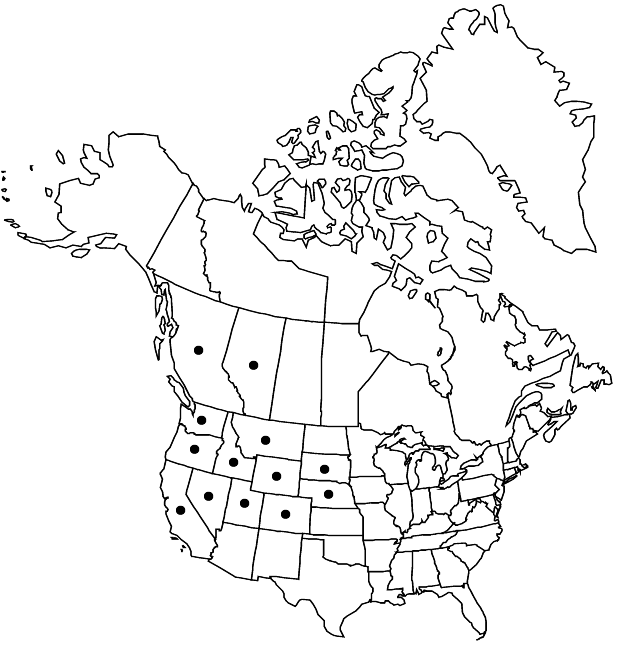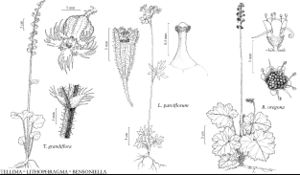Difference between revisions of "Lithophragma parviflorum"
in J. Torrey and A. Gray, Fl. N. Amer. 1: 584. 1840 (as parviflora) ,.
FNA>Volume Importer |
FNA>Volume Importer |
||
| Line 14: | Line 14: | ||
|name=Lithophragma anemonoides | |name=Lithophragma anemonoides | ||
|authority=Greene | |authority=Greene | ||
| − | }}{{Treatment/ID/Synonym | + | }} {{Treatment/ID/Synonym |
|name=Lithophragma austromontanum | |name=Lithophragma austromontanum | ||
|authority=A. Heller | |authority=A. Heller | ||
| − | }}{{Treatment/ID/Synonym | + | }} {{Treatment/ID/Synonym |
|name=Pleurendotria reniformis | |name=Pleurendotria reniformis | ||
|authority=Rafinesque | |authority=Rafinesque | ||
| Line 35: | Line 35: | ||
|elevation=200-3100 m | |elevation=200-3100 m | ||
|distribution=Alta.;B.C.;Calif.;Colo.;Idaho;Mont.;Nebr.;Nev.;Oreg.;S.Dak.;Utah;Wash.;Wyo. | |distribution=Alta.;B.C.;Calif.;Colo.;Idaho;Mont.;Nebr.;Nev.;Oreg.;S.Dak.;Utah;Wash.;Wyo. | ||
| − | |discussion=<p>Lithophragma parviflorum is easily identified throughout its range, although morphological variation is apparent when comparing specimens from different habitats and elevations in western North America. Some authors treat L. trifoliatum as a variety of L. parviflorum.</p> | + | |discussion=<p><i>Lithophragma parviflorum</i> is easily identified throughout its range, although morphological variation is apparent when comparing specimens from different habitats and elevations in western North America. Some authors treat <i>L. trifoliatum</i> as a variety of <i>L. parviflorum</i>.</p> |
|tables= | |tables= | ||
|references= | |references= | ||
| Line 59: | Line 59: | ||
|publication year= | |publication year= | ||
|special status= | |special status= | ||
| − | |source xml=https://jpend@bitbucket.org/aafc-mbb/fna-data-curation.git/src/ | + | |source xml=https://jpend@bitbucket.org/aafc-mbb/fna-data-curation.git/src/8f726806613d60c220dc4493de13607dd3150896/coarse_grained_fna_xml/V8/V8_154.xml |
|genus=Lithophragma | |genus=Lithophragma | ||
|species=Lithophragma parviflorum | |species=Lithophragma parviflorum | ||
Revision as of 18:04, 18 September 2019
Plants slender. Flowering stems simple, 20–50 cm. Leaves in basal rosette and cauline, basal mostly 3-lobed, cauline (2–3), 3-foliolate, reduced, similar to basal (except lobes longer); stipules large, decurrent on petiole base, (margins fimbriate); petiole to 6 cm; blade dark green, orbiculate, (base cuneate), surfaces nearly glabrous or sparsely to densely hairy. Inflorescences 2–3, nodding, 4–14-flowered racemes, simple. Pedicels equaling or shorter than hypanthium. Flowers deciduous if unfertilized, not fragrant, horizontal; hypanthium obconic-elongate at anthesis, becoming very elongate in fruit, open at throat, (length 2 times diam.); sepals erect, triangular; petals (exserted), widely spreading, white or pink, often with prominent venation, obovate-rhombic, narrowly clawed, deeply 3-lobed, (usually with prominent sinuses extending 1/2+ to base), 7–16 mm, ultimate margins entire; ovary 1/2+ inferior; styles included in fruit; stigma papillae in narrow subapical band. Seeds 0.5–0.6 mm, wrinkled or smooth. 2n = 14, 21, 28, 35.
Phenology: Flowering Mar–Aug.
Habitat: Coastal bluffs, gravel prairies and rocky meadows, open forests, shrublands, and grasslands, subalpine regions, commonly with Lithophragma glabrum and L. tenellum
Elevation: 200-3100 m
Distribution

Alta., B.C., Calif., Colo., Idaho, Mont., Nebr., Nev., Oreg., S.Dak., Utah, Wash., Wyo.
Discussion
Lithophragma parviflorum is easily identified throughout its range, although morphological variation is apparent when comparing specimens from different habitats and elevations in western North America. Some authors treat L. trifoliatum as a variety of L. parviflorum.
Selected References
None.
